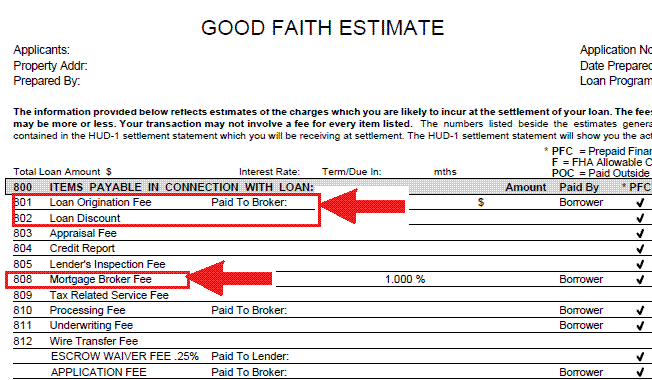Yesterday, mortgage backed securities (MBS) traded in a tight range and closed near the previous day's closing price levels. This stability will allow lenders to offer par 30 year conventional mortgages ranging from 4.625% to 4.875% depending on individual borrower risk profile characteristics
To qualify for a par interest rate requires a FICO score of at least 740 with a loan amount to home value ratio of 80% or less. This also assumes that borrowers pay all closing costs which includes 1 origination/discount point or broker charge(how mortgage bankers and brokers earn income. I bring up this topic due to a recent conversation I had with a reader. This reader sent me an email indicating they had been quoted a specific zero point mortgage rate, as is the usual reaction to such a statement I requested this reader to please send me their good faith estimate. Sure enough, there were no points; however, upon further inspection I noticed a 1.00% closing cost labeled "broker fee"(see example below). So although the "fees" were not described as "points", this client was still paying the same amount. Consumers beware of how lenders structure your good faith estimates.

That said, I am not bashing the added cost of origination or discount points but I would like to point out that these "points" and "fees" should go towards a lower rate. I encourage everyone who is refinancing to request a zero point/fee mortgage rate and a 1 point mortgage rate. If you are staying in the home for more than 3 years, paying the point and securing a lower rate will pay for itself and more than likely be the better deal. You are able to determine this breakeven point by calculating the difference between the two mortgage payments (0 point vs. 1 point quote) and comparing to the cost of the "points/fees" that you pay. If you save $100/per month divide that savings by the dollar amount of points you pay to determine the number of months it will take to make up the cost of "points/fees". If you believe you will be in house for a period longer than it takes to recover this cost...I would suggest paying the point in favor of a lower rate.
I also had a reader comment yesterday about an offer they received on a refinance where the lender was “absorbing the costs”. Well, it appears that way on the surface when you get a good faith estimate that shows the lender paying all the fees; however, the rate they were quoted was abnormally higher than the average market par rate. So, is the lender absorbing the costs, or is this consumer paying the costs via a higher interest rate? If the latter is the case the consumer will pay more money in the long run vs. paying costs up front. Has this concept been presented to you by your mortgage professional? Have you experienced this dilemma. Should you pay additional closing costs? Should you pay a point? ? As always I am interested in hearing your thoughts on the subject.
I have written in the past about lenders controlling their pipeline of business by increasing borrowing costs for no apparent reason. It was reported yesterday by a fellow mortgage professional of one lender doing this. With the price action of MBS yesterday, there was no reason for any lender to worsen pricing but that is what happened. As lenders start to offer better rates, many consumers jump off the fence and lock their rate. Once the lender gets enough locks, they start to increase rates to slow down their volume of new originations.
Onto the data for the day.
First we got the release of housing starts which showed construction of new homes declining sharply last month to an annual pace of 510,000 from February’s annual pace of 583,000. This is the second lowest reading on record. Economists had expected this report to show an annual pace of 570,000. This report is a positive for MBS and lower mortgage rates but not much reaction from the markets. With a glut of housing on the market, I am happy to see this come in lower. Less new homes being built will help the supply of existing homes to move lower.
Next, the Labor department released the Weekly Claims for Unemployment Insurance. This report shows the number of Americans who have filed for unemployment insurance for the first time each week. We got mixed data with the weekly jobless claims unexpectedly improving from an estimate of 658,000 to 610,000 which is down 53,000 from the prior week. The continuing claims which gives us a reading of the number of Americans that continue to file for unemployment insurance set another record at 6,022,000. This is the 13th week in a row that this has set a new record high reading and continues to show that unemployed Americans are having a difficult time securing a new job. This suggests that the worst has yet to come in regards to unemployment data.
Lastly, we received the monthly Philadelphia Fed Survey which gives investors insight into the business conditions around the Philadelphia region. Expectations were for a reading of -30.2 following last months -35.0. Readings below 0 indicate a contracting economy and readings above 0 indicate an expanding or growing economy. The report came in better than expectations at -24.4 but still shows the manufacturing segment of our economy contracting. On the news, there was no reaction from the markets.
So far this morning, MBS have continued to trade in a tight range. Early reports from fellow mortgage professionals show at least 1 lender offering 4.5% as par today. For intraday updates on the status of the markets, please check out the MBS Commentary.




